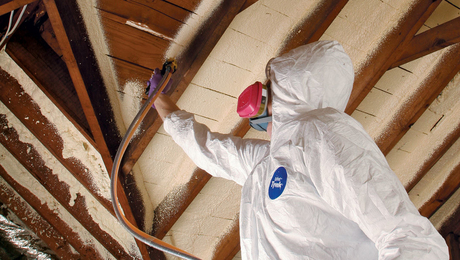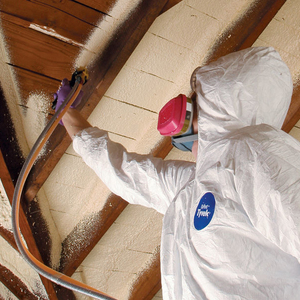Dealing with a grossly out of level, nonflat concrete floor
Hello,
I am in the process of converting an attached two car garage into living space. The work is permitted. I am the homeowner but acting as GC. My question is related to a ~60 year old concrete slab that has settled significantly. The settling is exclusively on one side of the garage (closest to the house). It has settled ~2 1/2 to 3″ along about 2/3rds of the north wall abutting the house. Point of clarity – the foundation itself is sound. The house itself appears as plum and level as the day it was built. It is just the garage slab (and not the exterior walls) that has settled. The exterior walls of the garage are brick and block built on a 40″ deep continuous footing (which I have spot dug to verify).
The inspector is ok with the slab’s condition (I had asked if it needed to be ripped out and replaced and he said no). The permitted plans call for a typical installation of poly sheeting followed by sleepers, subfloor, flooring. I also will be adding a substantial amound of XPS rigid foam to bring the floor up to at least R-10 (I will probably shoot for R-15 or R-20).
My question is how to deal with the significant and uneven slope in the garage slab? As mentioned above the high and low point in the garage slab differ by ~3″. I’ve thought about all of the following ideas. I’m wondering if any of these would be preferred:
- Install 6 mm plastic, 2-3″ of continuous XPS (taped at seams), secure 2×4 PT on side with tapcons, then scribe and cut 2×8 sleepers so that the top each sleeper is level. Seems like a lot of work to do this scribing & cutting.
- Pour a boat load of self leveling cement before installing the same concept as #1 (eliminating the need to scribe cut the sleepers) I have no interest in mixing 60+ bags of cement so this is not my preference.
- Pour a boat load of leveled sand before installing the same concept as #1 (also eliminating the need for a scribe cut).
- Forget the concept of sleepers entirely and install the joists to the cement block walls with a ledger board (just like I was building a deck). The walls have not settled, only the slab.
I plan to e-mail the inspector with the same question.
Thank you,
Brian



















Replies
How much space will there be between the slab and the bottom of the subfloor?
one scenario:
Dan's got a good question about relative height between floor structure and slab. It would be helpful to know that.
However, I would consider this scenario (anyhow ( and if you're not worried about floor continuing to settle):
1. Install contiuous vapor barrier (lapped up wall to above floor finish ht.)
2. run P.T. ledger and joists. If joists are narrow for spans, then you can vertical block at 1/2 or even 1/3 span (use coated structural scews to avoid potential squeaks) simply attached to the sides of joists. Keep block height about 1/4" below top of joists to allow for joist shrinkage. This is quick, easy, and inexpensive way to stiffen floor once you have all your joists in place.
3. Run any wiring, cabling, etc.
4. Get a close-in inspection
5. Spray foam floor cavity with closed cell foam to code or desired R-value.
6. Get partial insulation inspection (if necessary)
7. Deck it.
answer to question
Ugh. I think my situation is problematic. I used a laser level to measure the distance between the required floor height and the highest point of the slab. The high point is just shy of 10" clearance. The low point is roughly 13" clearance. Most of the variance in clearance is along the north wall where the slab has cracked and settled (~1/4 of the entire area of the garage).
I'm not an expert on span tables for joists but clearly anything above a 2x10 joist won't work at all. A 5/8" subfloor would leave me almost nothing left for a finished floor. The old garage is a standard 22'x22' so I assume a beam in the center would be required. That beam probably won't be thick enough unless it is built resting on the ground as a sleeper (I assume this is acceptable).
Also, I've been reading about securing ledger boards to hollow concrete block (which is my situation) and that sounds like a real challenge as well. I'll speak to our BI about what methods they will accept.
If anyone has further suggestions please let me know.
Thank you,
Brian
The beam wouldn't have to be under the joists, it could be flush and the joists would hang from beam to ledger. I don't see how hanging a ledger to block would be a problem.
why the need for a beam?
I don't see that you need a beam to support your joists. If it were mine, I would frame with 2x8's with a 2x10 ledger. Then veritical block the 2x8 joists with 2x4 P.T. at the 1/3 points of joist span.
Remember, you can use the existing concrete slab for bearing--particularly if it's nolonger settling*. Also your ledger will be taking partical load to walls. The slab is only taking partial load. You can check with an engineer, but my guess is your floor would be rock solid this way. And easy to build.
Using Hilti epoxy sleeve anchors to fasten ledger to block walls. We do it all the time
Another thought on insuating your slab since you have 10-13" which don't need to be completely filled. If you don't want to spray foam later, then put your vapor barrier down, then your XPS sheets and block down on top of that. YOu can spread the load from 2x4's by bearing onto (prenail as an inverted "t" prop) 2' pieces of cut off 2x8 joists (order a few extra). IMO, the XPS will handle the bearing no problme. As a matter of fact, with a good vapor barrier and the XPS, you should be able to use SPF framing lumber for your floor system. You will be vapor open to the finish floor only.
* If your slab is continuing to settle more than 3" after 60 years, then you probably have soil or other drainage issues that should be looked at.
Deadnuts,
Your suggestions make perfect sense. I will reach out to my township's building inspector. I have to believe this approach will get approved.
Thank you for your thoughts.
Brian
Brian,
Further thoughts on slab bearing conditions:
Since you're going to be covering it, you can cut/break small sections near the house to see if soil has settled under the slab any further. My guess is that you had inadequately tamped backfill at the main house. Happens all the time.
If there is no space between subgrade and slab, you should be fully setteled.
If there is some space, then the slab is bridging against the house by geometery or simply acting as a weak cantilever towards the house with the main section that is furtherest away from the house acting as ballast. Either way, the soil underneath has probably settled all it is going to after 60 years. You then have two options:
1. close up your test holes and hire someone to mud jack the slab to stabilize it for piece of mind. This would be the professional way to do it.
2. open up the holes a bit more and dig piers to solid bearing (if practical) and pour these yourself. You might need a series of them about 4-6 feet apart. You can pour the top portion of piers very wet to allow concrete to spread out into the void just under slab. Sort of a poor man's mud jacking operation. For the condition you will be building, this should give you a D.I.Y. piece of mind solution.